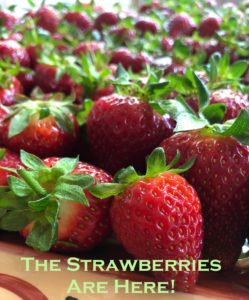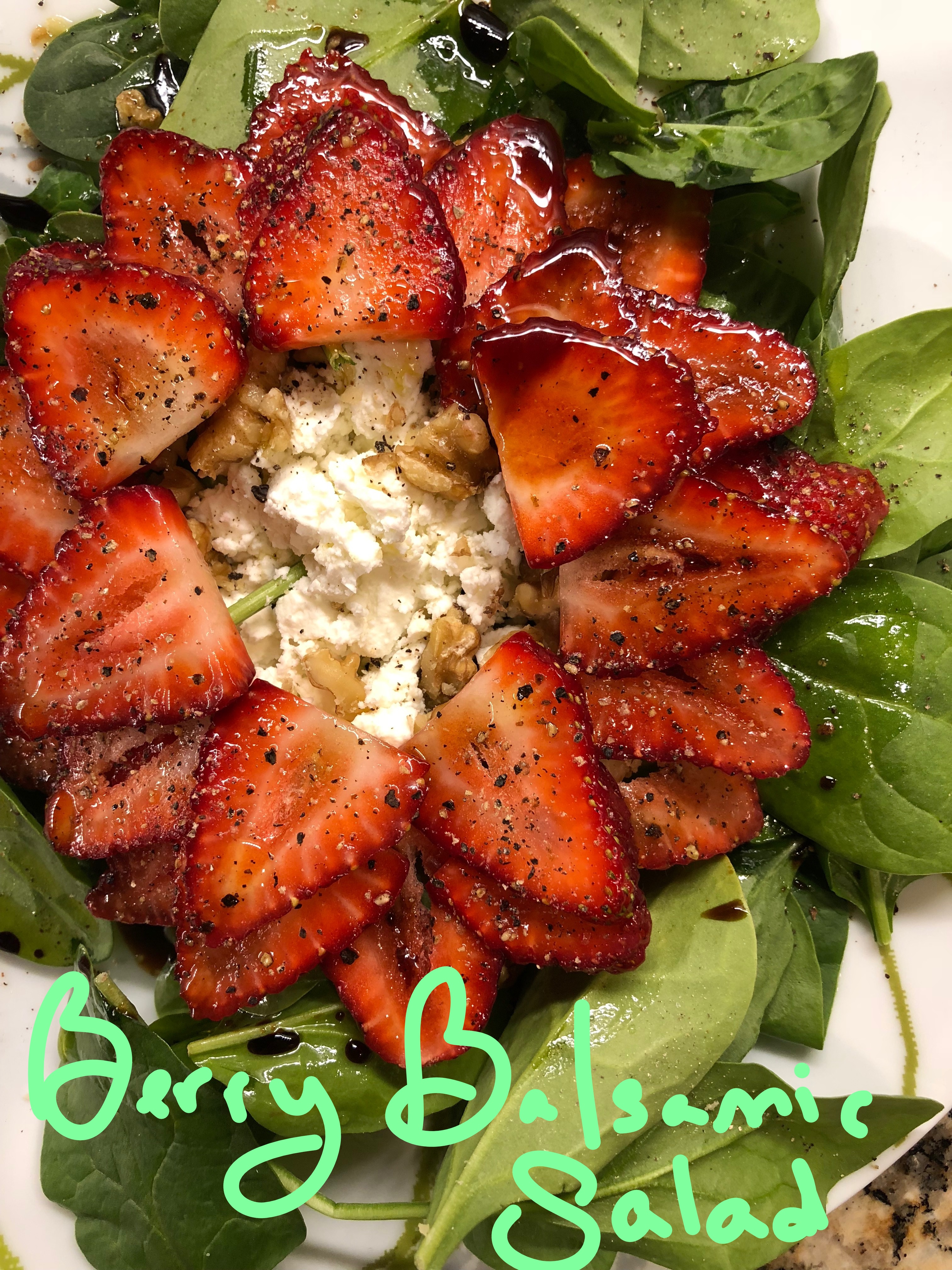
The strawberries are here! The strawberries are here!
Last weekend, Karthik, Ajay, and I (accompanied by my mother, a veteran grow/pick-your-own-fruiter) went strawberry picking for the first time. Karthik and I, with perhaps with more eagerness than experience, quickly filled two buckets with strawberries. Maybe if Ajay joined us earlier, we could have followed his example, examining each strawberry more closely to make sure it was red all the way to the top as instructed by the farm’s staff. But baby boy spent the first half hour snoozing in the car with Grandma instead; and on waking up, he inspected one strawberry for a minute before deciding he would rather watch cars passing by on the road.



Still—the strawberries are here! The strawberries are here!
Freshly picked strawberries shine every time, even when picked by newbies like me. The sweet strawberry aroma that catches you as you walk by; ripe berries that are bright red and unmarred, no bruise or mold in sight. Compare that with the rock-hard, sour fruit that gets plucked two days early in lands afar and still manages to arrive moldy at your local grocery chain.

One of my perennial favorite uses for fresh strawberries is combining them with baby spinach and balsamic vinegar for a crisp, sweet-and-tart salad. By no means is this an especially original combination. Consider it a classic that satisfies year after year as the other trendy salads come and go. And there’s still plenty of room for substitutions in this “recipe” (see the notes below; it’s really more a listing of ingredients, because there’s not much to do but chop and assemble). There’s one ingredient besides fresh, in-season berries, however, that really makes this salad: your choice of balsamic vinegar. So much so that I want to spend a little more time discussing it.

Now, many of y’all may already know this, but until I read Real Food, Fake Food last year, I never realized that the stuff most grocery stores sell isn’t “real” balsamic vinegar. “Real” balsamic vinegar— Aceto Balsamico Tradizionale, D.O.P made of pure grape must and aged for 12+ years in wooden barrels in Italy—can cost over $100 for a 100 milliliter bottle.
That’s not even half a cupful of vinegar. No wonder I can’t find any at Kroger.
So what exactly is that stuff on the typical grocery store shelf? Most likely, those vinegars fall into two categories: imitation balsamic vinegar and Aceto Balsamico di Modena I.G.P. Supposedly (according to Serious Eats) there is high quality Aceto Balsamico di Modena I.G.P. that costs $50 a bottle. I haven’t yet run across those vinegars, however; much of the Aceto Balsamico di Modena I.G.P. (note, by the way, the absence of the word “Tradizionale”/traditional and the less stringent I.G.P designation compared to the label for “real” balsamic vinegar) that I see in grocery stores comes with added coloring, sweeteners, or thickeners to boost their flavor and texture. All the I.G.P. label guarantees in this case is that the grapes are varietals traditionally used to make balsamic vinegar (they could be grown anywhere) and that the vinegar is processed somewhere in Modena, Italy.

For that, I might as well buy a cheaper imitation balsamic vinegar without all that extra stuff added. And yes, that is what I did for many years. I read the labels of bottles of both I.G.P and imitation balsamic and picked the ones that only listed vinegar and grape must, without added sulfites, sweeteners, thickeners, or coloring. And my berry balsamic salad was good. Not outstanding, but pretty good. I sometimes wondered what the big fuss was about balsamic vinegar was if so many producers needed to include all those additives to boost its taste, even in some of the pricier bottles. Only after reading Real Food, Fake Food did I understand that no matter how much I paid for them, the problem was that none of those vinegars were, well, real balsamic vinegar.

Aceto Balsamico Tradizionale, D.O.P is still too pricy for my home-cooking budget, especially for sprinkling over salad on a daily basis; it’s the kind of treat drizzled over dessert and cheese on special occasions. Luckily, there are tastier alternatives to all those low-quality imitation balsamic vinegars and I.G.P. balsamic vinegars. This year, I ventured into my local olive oil boutique, the Leaning Ladder in downtown Woodstock, and discovered that in addition to all the flavored oils and vinegars, they carry a traditional-style vinegar which claims to be comparable to Aceto Balsamico Tradizionale, D.O.P. Brewed, fermented, and aged using the traditional method, this vinegar does not meet D.O.P requirements only because of a small amount of red wine vinegar introduced during the process. I tried a sample and realized that this balsamic vinegar was an altogether different type of food than the ones I used previously: viscous, tart, and sweet, bursting with intense, fruity, wine-like flavors.**

Many specialty food stores and chains carry similarly high-quality, traditionally produced balsamic vinegars that, for some reason or another, don’t satisfy the requirements for a D.O.P. label. Sometimes they are labeled condimento. Because condimento is not a protected term, the quality can still vary—if your local purveyor of high-quality balsamic vinegars offers a taste test, definitively try some out before purchasing. And if you find a good balsamic vinegar like I did, buy it and use it for this salad!
Because of the vinegar’s concentrated flavor and thickness, a little goes a long way. So even though my balsamic vinegar condimento cost a little more (and truly only a little more, it’s nowhere near the price of Aceto Balsamico Tradizionale, D.O.P) than the lower quality balsamic vinegars, my bottle lasts a long time. Which means that as strawberry season becomes blueberry and raspberry season, you and I can continue to enjoy this classic salad.

Recipe notes:
-
- As mentioned above, high quality balsamic vinegar really elevates the flavor of this salad. Invest in some if you can.
- My preferred green for this salad is baby spinach, especially when using strawberries. A baby lettuce/spring mixture may also work. As much as I love more bitter greens such as arugula and kale, they don’t pair as well with strawberries (although they do work well with blueberries and raspberries).
- I like raw walnuts, but if you preferred toasted, stick them on a pan and bake at 350⁰F for 8-10 minutes. Pecans and hazelnuts also work well for this salad.
- Save money: crumble your own goat cheese using a butter knife.
**Note: Spice and Kisses at present is a labor of love (in other words, I don’t make any money from it). So this recommendation is made because the product was great, not because anyone paid me to write this.
Berry Balsamic Salad
Ingredients
- 5 oz baby spinach, washed and dried
- 10-12 strawberries (chopped however you prefer)
- 2 oz soft chevre-style goat cheese, crumbled (use a butter knife)
- ½ cup roughly chopped walnuts
- 4 tbsp extra virgin olive oil
- 4 tsp balsamic vinegar
- Salt
- Coarse ground black pepper (or use a pepper mill)
Instructions
Assemble the salad:
- In a salad bowl or on individual plates, layer strawberries, crumbled goat cheese, and walnuts over a bed of the baby spinach.
- Note that the above quantities are suggestions. If you want more strawberries, less goat cheese, etcetera, adjust as you wish.
Dress the salad:
- Drizzle olive oil and balsamic vinegar over the dressing. Again, this is to taste depending on how heavily (or lightly) you prefer to dress your salad and the quality of your balsamic vinegar. I typically use ½-1 tbsp extra virgin olive oil and ½-1 tsp of high quality balsamic vinegar per serving of salad.
- Sprinkle with salt and pepper to taste—I sprinkle a small pinch of salt over each serving and like to go heavy on the pepper, about 8-10 cranks of my pepper mill.
- Serve immediately.


